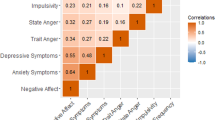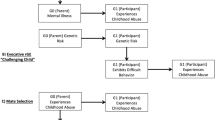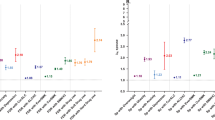Abstract
Abnormalities in the gamma-aminobutyric acid (GABA) neurotransmitter system have been noted in subjects with mood and anxiety disorders. Glutamic acid decarboxylase (GAD) enzymes synthesize GABA from glutamate, and, thus, are reasonable candidate susceptibility genes for these conditions. In this study, we examined the GAD1 and GAD2 genes for their association with genetic risk across a range of internalizing disorders. We used multivariate structural equation modeling to identify common genetic risk factors for major depression, generalized anxiety disorder, panic disorder, agoraphobia, social phobia and neuroticism (N) in a sample of 9270 adult subjects from the population-based Virginia Adult Twin Study of Psychiatric and Substance Use Disorders. One member from each twin pair for whom DNA was available was selected as a case or control based on scoring at the extremes of the genetic factor extracted from the analysis. The resulting sample of 589 cases and 539 controls was entered into a two-stage association study in which candidate loci were screened in stage 1, the positive results of which were tested for replication in stage 2. Several of the six single-nucleotide polymorphisms tested in the GAD1 region demonstrated significant association in both stages, and a combined analysis in all 1128 subjects indicated that they formed a common high-risk haplotype that was significantly over-represented in cases (P=0.003) with effect size OR=1.23. Out of 14 GAD2 markers screened in stage 1, only one met the threshold criteria for follow-up in stage 2. This marker, plus three others that formed significant haplotype combinations in stage 1, did not replicate their association with the phenotype in stage 2. Subject to confirmation in an independent sample, our study suggests that variations in the GAD1 gene may contribute to individual differences in N and impact susceptibility across a range of anxiety disorders and major depression.
This is a preview of subscription content, access via your institution
Access options
Subscribe to this journal
Receive 12 print issues and online access
$259.00 per year
only $21.58 per issue
Buy this article
- Purchase on Springer Link
- Instant access to full article PDF
Prices may be subject to local taxes which are calculated during checkout




Similar content being viewed by others
References
Sullivan PF, Neale MC, Kendler KS . Genetic epidemiology of major depression: review and meta-analysis. Am J Psychiatry 2000; 157: 1552–1562.
Hettema JM, Neale MC, Kendler KS . A review and meta-analysis of the genetic epidemiology of anxiety disorders. Am J Psychiatry 2001; 158: 1568–1578.
Maser JD, Cloninger CR (eds) Comorbidity of Mood and Anxiety Disorders. American Psychiatric Press: Washington, DC, 1990.
Middeldorp CM, Cath DC, Van Dyck R, Boomsma DI . The co-morbidity of anxiety and depression in the perspective of genetic epidemiology. A review of twin and family studies. Psychol Med 2005; 35: 611–624.
Jardine R, Martin NG, Henderson AS . Genetic covariation between neuroticism and the symptoms of anxiety and depression. Genet Epidemiol 1984; 1: 89–107.
Fanous A, Gardner CO, Prescott CA, Cancro R, Kendler KS . Neuroticism, major depression and gender: a population-based twin study. Psychol Med 2002; 32: 719–728.
Hettema JM, Prescott CA, Kendler KS . Genetic and environmental sources of covariation between generalized anxiety disorder and neuroticism. Am J Psychiatry 2004; 161: 1581–1587.
Smoller JM, Tsuang MT . Panic and phobic anxiety: defining phenotypes for genetic studies. Am J Psychiatry 1998; 155: 1152–1162.
Nash MW, Huezo-Diaz P, Williamson RJ, Sterne A, Purcell S, Hoda F et al. Genome-wide linkage analysis of a composite index of neuroticism and mood-related scales in extreme selected sibships. Hum Mol Genet 2004; 13: 2173–2182.
Kirk KM, Birley AJ, Statham DJ, Haddon B, Lake RI, Andrews JG et al. Anxiety and depression in twin and sib pairs extremely discordant and concordant for neuroticism: prodromus to a linkage study. Twins Res 2000; 3: 299–309.
Hettema JM, Prescott CA, Myers JM, Neale MC, Kendler KS . The structure of genetic and environmental risk factors for anxiety disorders in men and women. Arch Gen Psychiatry 2005; 62: 182–189.
Kendler KS, Walters EE, Neale MC, Kessler RC, Heath AC, Eaves LJ . The structure of the genetic and environmental risk factors for six major psychiatric disorders in women: phobia, generalized anxiety disorder, panic disorder, bulimia, major depression and alcoholism. Arch Gen Psychiatry 1995; 52: 374–383.
Kendler KS, Prescott CA, Myers J, Neale MC . The structure of genetic and environmental risk factors for common psychiatric and substance use disorders in men and women. Arch Gen Psychiatry 2003; 60: 929–937.
Van Gestel S, Houwing-Duistermaat JJ, Adolfsson R, van Duijn CM, Van Broeckhoven C . Power of selective genotyping in genetic association analyses of quantitative traits. Behav Genet 2000; 30: 141–146.
van den Oord EJCG . A comparison between different designs and tests to detect QTLs in association studies. Behav Genet 1999; 29: 245–256.
Schork NJ, Nath SK, Fallin D, Chakravarti A . Linkage disequilibrium analysis of biallelic DNA markers, human quantitative trait loci, and threshold-defined case and control subjects. Am J Hum Genet 2000; 67: 1208–1218.
Petty F, Kramer GL, Dunnam D, Rush AJ . Plasma GABA in mood disorders. Psychopharmacol Bull 1990; 26: 157–161.
Kasa K, Otsuki S, Yamamoto M, Sato M, Kuroda H, Ogawa N . Cerebrospinal fluid gamma-aminobutyric acid and homovanillic acid in depressive disorders. Biol Psychiatry 1982; 17: 877–883.
Goddard AW, Mason GF, Almai A, Rothman DL, Behar KL, Petroff OA et al. Reductions in occipital cortex GABA levels in panic disorder detected with 1h-magnetic resonance spectroscopy. Arch Gen Psychiatry 2001; 58: 556–561.
Sanacora G, Gueorguieva R, Epperson CN, Wu YT, Appel M, Rothman DL et al. Subtype-specific alterations of gamma-aminobutyric acid and glutamate in patients with major depression. Arch Gen Psychiatry 2004; 61: 705–713.
Kaufman DL, Houser CR, Tobin AJ . Two forms of the gamma-aminobutyric acid synthetic enzyme glutamate decarboxylase have distinct intraneuronal distributions and cofactor interactions. J Neurochem 1991; 56: 720–723.
Martin DL, Rimvall K . Regulation of gamma-aminobutyric acid synthesis in the brain. J Neurochem 1993; 60: 395–407.
Bowers G, Cullinan WE, Herman JP . Region-specific regulation of glutamic acid decarboxylase (GAD) mRNA expression in central stress circuits. J Neurosci 1998; 18: 5938–5947.
Esclapez M, Tillakaratne NJ, Kaufman DL, Tobin AJ, Houser CR . Comparative localization of two forms of glutamic acid decarboxylase and their mRNAs in rat brain supports the concept of functional differences between the forms. J Neurosci 1994; 14(Part 2): 1834–1855.
Feldblum S, Erlander MG, Tobin AJ . Different distributions of GAD65 and GAD67 mRNAs suggest that the two glutamate decarboxylases play distinctive functional roles. J Neurosci Res 1993; 34: 689–706.
Pitkanen A, Amaral DG . The distribution of GABAergic cells, fibers, and terminals in the monkey amygdaloid complex: an immunohistochemical and in situ hybridization study. J Neurosci 1994; 14: 2200–2224.
Stork O, Yamanaka H, Stork S, Kume N, Obata K . Altered conditioned fear behavior in glutamate decarboxylase 65 null mutant mice. Genes Brain Behav 2003; 2: 65–70.
Kash SF, Tecott LH, Hodge C, Baekkeskov S . Increased anxiety and altered responses to anxiolytics in mice deficient in the 65-kDa isoform of glutamic acid decarboxylase. Proc Natl Acad Sci USA 1999; 96: 1698–1703.
Asada H, Kawamura Y, Maruyama K, Kume H, Ding R, Ji FY et al. Mice lacking the 65 kDa isoform of glutamic acid decarboxylase (GAD65) maintain normal levels of GAD67 and GABA in their brains but are susceptible to seizures. Biochem Biophys Res Commun 1996; 229: 891–895.
Asada H, Kawamura Y, Maruyama K, Kume H, Ding RG, Kanbara N et al. Cleft palate and decreased brain gamma-aminobutyric acid in mice lacking the 67-kDa isoform of glutamic acid decarboxylase. Proc Natl Acad Sci USA 1997; 94: 6496–6499.
Kaiya H, Namba M, Yoshida H, Nakamura S . Plasma glutamate decarboxylase activity in neuropsychiatry. Psychiatry Res 1982; 6: 335–343.
Smoller JW, Rosenbaum JF, Biederman J, Susswein LS, Kennedy J, Kagan J et al. Genetic association analysis of behavioral inhibition using candidate loci from mouse models. Am J Med Genet 2001; 105: 226–235.
Lappalainen J, Sanacora G, Kranzler HR, Malison R, Hibbard ES, Price LH et al. Mutation screen of the glutamate decarboxylase-67 gene and haplotype association to unipolar depression. Am J Med Genet B Neuropsychiatr Genet 2004; 124: 81–86.
Lundorf MD, Buttenschon HN, Foldager L, Blackwood DH, Muir WJ, Murray V et al. Mutational screening and association study of glutamate decarboxylase 1 as a candidate susceptibility gene for bipolar affective disorder and schizophrenia. Am J Med Genet B Neuropsychiatr Genet 2005; 135: 94–101.
Kendler KS, Prescott CA . A population-based twin study of lifetime major depression in men and women. Arch Gen Psychiatry 1999; 56: 39–44.
Spitzer RL, Williams JBW . Structured Clinical Interview for DSM-III-R (SCID). Biometrics Research Department, New York State Psychiatric Institute: New York, 1985.
American Psychiatric Association. Diagnostic and Statistical Manual of Mental Disorders, revised 3rd edn. American Psychiatric Association: Washington, DC, 1987.
Hettema JM, Prescott CA, Kendler KS . A population-based twin study of generalized anxiety disorder in men and women. J Nerv Ment Dis 2001; 189: 413–420.
Kendler KS, Gardner CO, Prescott CA . Panic syndromes in a population-based sample of male and female twins. Psychol Med 2001; 31: 989–1000.
American Psychiatric Association. Diagnostic and Statistical Manual of Mental Disorders, 3rd edn. American Psychiatric Association: Washington, DC, 1980.
Kendler KS, Myers J, Prescott CA, Neale MC . The genetic epidemiology of irrational fears and phobias in men. Arch Gen Psychiatry 2001; 58: 257–265.
Eysenck HJ&ESBG. Manual of the Eysenck Personality Questionnaire. Hodder and Stoughton: London, 1975.
Robles JR, van den Oord EJ . lga972: a cross-platform application for optimizing LD studies using a genetic algorithm. Bioinformatics 2004; 20: 3244–3245.
van den Oord EJ, Sullivan PF . A framework for controlling false discovery rates and minimizing the amount of genotyping in the search for disease mutations. Hum Hered 2003; 56: 188–199.
Neale MC, Boker SM, Xie G, Maes HH . Mx: Statistical Modeling, 5th edn. Department of Psychiatry, Medical College of VA of VA Commonwealth University: Richmond, VA, 1999.
Kendler KS, Neale MC, Kessler RC, Heath AC, Eaves LJ . The genetic epidemiology of phobias in women. The interrelationship of agoraphobia, social phobia, situational phobia, and simple phobia. Arch Gen Psychiatry 1992; 49: 273–281.
Neale MC, Cardon LR . Methodology for Genetic Studies of Twins and Families. Kluwer Academic Publishers BV: Dordrecht, The Netherlands, 1992.
Hettema JM, Neale MC, Myers JM, Prescott CA, Kendler KS . A population-based twin study of the relationship between neuroticism and internalizing disorders. Am J Psychiatry 2006; 163: 857–864.
Barrett JC, Fry B, Maller J, Daly MJ . The International HapMap Project. Nature 2003; 426: 789–796.
Lowe CE, Cooper JD, Chapman JM, Barratt BJ, Twells RC, Green EA et al. Cost-effective analysis of candidate genes using htSNPs: a staged approach. Genes Immun 2004; 5: 301–305.
Bukszár J, Van den Oord EJCG . An asymptotic approximation for Pearson's statistic in two-stage genetic designs where data are pooled. Biometrics 2005 (in press).
Bukszár J, Van den Oord EJCG . Accurate and efficient power calculations for 2 × m tables in unmatched case–control designs. Statist Med 2005 (e-published 18 July 2005).
Niu T, Qin ZS, Xu X, Liu JS . Bayesian haplotype inference for multiple linked single-nucleotide polymorphisms. Am J Hum Genet 2002; 70: 157–169.
Qin ZS, Niu T, Liu JS . Partition-ligation-expectation-maximization algorithm for haplotype inference with single-nucleotide polymorphisms. Am J Hum Genet 2002; 71: 1242–1247.
Stram DO . Tag SNP selection for association studies. Genet Epidemiol 2004; 27: 365–374.
Barrett JC, Fry B, Maller J, Daly MJ . Haploview: analysis and visualization of LD and haplotype maps. Bioinformatics 2005; 21: 263–265.
Gabriel SB, Schaffner SF, Nguyen H, Moore JM, Roy J, Blumenstiel B et al. The structure of haplotype blocks in the human genome. Science 2002; 296: 2225–2229.
Dudbridge F . Pedigree disequilibrium tests for multilocus haplotypes. Genet Epidemiol 2003; 25: 115–121.
Excoffier L, Slatkin M . Maximum-likelihood estimation of molecular haplotype frequencies in a diploid population. Mol Biol Evol 1995; 12: 921–927.
Colhoun HM, McKeigue PM, Davey SG . Problems of reporting genetic associations with complex outcomes. Lancet 2003; 361: 865–872.
Freimer N, Sabatti C . The use of pedigree, sib-pair and association studies of common diseases for genetic mapping and epidemiology. Nat Genet 2004; 36: 1045–1051.
Van den Oord EJCG . Controlling false discoveries in candidate gene studies. Mol Psychiatry 2005; 10: 230–231.
Storey J, Tibshirani R . Statistical significance for genome-wide studies. Proc Natl Acad Sci USA 2003; 100: 9440–9445.
Wacholder S, Chanock S, Garcia-Closas M, El Ghormli L, Rothman N . Assessing the probability that a positive report is false: an approach for molecular epidemiology studies. J Natl Cancer Inst 2004; 96: 434–442.
Van den Oord EJCG, Sullivan PF . False discoveries and models for gene discovery. Trends Genet 2003; 19: 537–542.
Ioannidis JP, Ntzani EE, Trikalinos TA, Contopoulos-Ioannidis DG . Replication validity of genetic association studies. Nat Genet 2001; 29: 306–309.
Straub RE, Sullivan PF, Ma Y, Myakishev MV, Harris-Kerr C, Wormley B et al. Susceptibility genes for nicotine dependence: a genome scan and followup in an independent sample suggest that regions on chromosomes 2, 4, 10, 16, 17 and 18 merit further study. Mol Psychiatry 1999; 4: 129–144.
Livak KJ . Allelic discrimination using fluorogenic probes and the 5′ nuclease assay. Genet Anal 1999; 14: 143–149.
SAS Institute. SAS/STAT Software: Version 8. SAS Institute Inc.: Cary, NC, 1999.
Pritchard JK, Stephens M, Donnelly P . Inference of population structure using multilocus genotype data. Genetics 2000; 155: 945–959.
Devlin B, Roeder K . Genomic control for association studies. Biometrics 1999; 55: 997–1004.
Freedman ML, Reich D, Penney KL, McDonald GJ, Mignault AA, Patterson N et al. Assessing the impact of population stratification on genetic association studies. Nat Genet 2004; 36: 388–393.
Sullivan PF, Neale MC, Silverman MA, Harris-Kerr C, Myakishev MV, Wormley B et al. An association study of DRD5 with smoking initiation and progression to nicotine dependence. Am J Med Genet 2001; 105: 259–265.
Acknowledgements
This work was supported by NIH grants MH-40828, MH-65322, MH-20030, DA-11287, MH/AA/DA-49492 to KSK and K08 MH-66277-1, as well as a Junior Faculty Research Award from the Anxiety Disorders Association of America, an NARSAD Young Investigator Award and a Pfizer/SWHR Scholars Award to JMH. We acknowledge the contribution of the Virginia Twin Registry, now part of the Mid-Atlantic Twin Registry (MATR), to ascertainment of subjects for this study. The MATR, directed by Drs J Silberg and L Eaves, has received support from the National Institutes of Health, the Carman Trust and the WM Keck, John Templeton and Robert Wood Johnson Foundations.
Author information
Authors and Affiliations
Corresponding author
Additional information
Preliminary results from this study were presented at the XIIIth World Congress on Psychiatric Genetics, October 14–18, 2005 in Boston, MA, USA.
Supplementary Information accompanies the paper on the Molecular Psychiatry website (http://www.nature.com/mp)
Supplementary information
Rights and permissions
About this article
Cite this article
Hettema, J., An, S., Neale, M. et al. Association between glutamic acid decarboxylase genes and anxiety disorders, major depression, and neuroticism. Mol Psychiatry 11, 752–762 (2006). https://doi.org/10.1038/sj.mp.4001845
Received:
Revised:
Accepted:
Published:
Issue Date:
DOI: https://doi.org/10.1038/sj.mp.4001845
Keywords
This article is cited by
-
Towards precision medicine for anxiety disorders: objective assessment, risk prediction, pharmacogenomics, and repurposed drugs
Molecular Psychiatry (2023)
-
Compositional changes and ecological characteristics of earthworm mucus under different electrical stimuli
Scientific Reports (2023)
-
The Ncoa7 locus regulates V-ATPase formation and function, neurodevelopment and behaviour
Cellular and Molecular Life Sciences (2021)
-
A major role for common genetic variation in anxiety disorders
Molecular Psychiatry (2020)
-
Rice Bran Metabolome Contains Amino Acids, Vitamins & Cofactors, and Phytochemicals with Medicinal and Nutritional Properties
Rice (2017)



